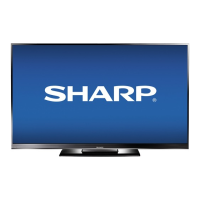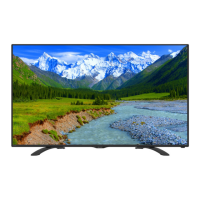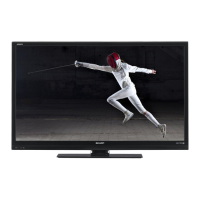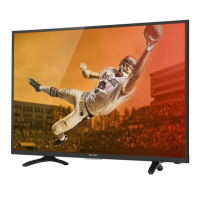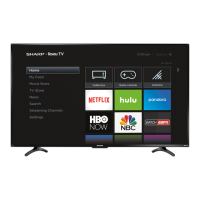
Do you have a question about the Sharp LC-50LB261U and is the answer not in the manual?
Guidelines for safe television placement to prevent tip-overs and injuries.
Essential safety recommendations for TV installation and use.
Advice on professional installation and choosing certified wall mounts.
Safety considerations for relocating older CRT televisions.
Warnings about electrical hazards and not opening the TV casing.
Precautions for lightning storms and proximity to power lines.
Advice on handling the LCD panel and using specified replacement parts.
Recommendation for routine safety checks after service or repair.
Guidelines for operating the TV from the correct power source and servicing.
Conditions that necessitate unplugging the TV and referring to service.
Advice on antenna grounding, condensation prevention, and mobile phone warnings.
Information on TV disposal, recycling, and explanation of non-active pixels.
Congratulates the user and introduces the Sharp LC-50LB261U TV.
Guide to connecting a Roku Streaming Stick for enhanced streaming capabilities.
Instructions for connecting MHL-enabled devices for screen mirroring.
Explanation of HDMI CEC for seamless device communication.
Details the audio quality benefits provided by DTS Sound.
Step-by-step instructions for attaching the TV stand securely.
Important notes regarding stand installation and future wall-mounting.
Warning about secure attachment and using UL Listed mounts.
The first step of carefully placing the TV face-down for wall mounting.
Information on screw types (M6) and mounting hole dimensions for wall mounts.
Details of items included in the package and the TV's front panel components.
Explanation of the function of each button on the TV's front panel.
Description of side panel jacks for audio, HDMI, MHL, and ARC connections.
Description of the USB port for connecting flash drives and other devices.
Description of back panel jacks for digital audio, component/AV, and antenna/cable.
Description of back panel jacks for PC video (VGA) and audio connections.
Detailed explanation of each button's function on the TV remote control.
Guide to choosing optimal connection types based on video quality and cable connectors.
Important safety precautions and advice for making secure TV connections.
Step-by-step instructions for connecting via HDMI for superior video quality.
How to connect a DVI device, noting the need for a separate audio connection.
Instructions for connecting via component video for improved quality over composite.
Instructions for connecting via composite video, often labeled AV.
How to connect an antenna or cable TV directly using a coaxial cable.
Tips on coaxial cables, signal strength, and troubleshooting reception issues.
Step-by-step guide for connecting DVD or Blu-ray players using HDMI.
Instructions for connecting DVD/Blu-ray players using component video cables.
Instructions for connecting DVD/Blu-ray players using composite AV cables.
Specific instruction to use the HDMI 2/MHL jack for connecting a Roku Streaming Stick.
Specific instruction to use the HDMI 2/MHL jack for connecting MHL-enabled devices.
Step-by-step guide for connecting game consoles using HDMI for optimal performance.
Instructions for connecting game consoles using component video cables.
Instructions for connecting game consoles using composite AV cables.
Step-by-step guide for connecting computers to the TV via HDMI.
How to connect a computer via DVI, noting the need for a separate audio connection.
Instructions for connecting computers using VGA and audio cables.
Warning against removing the USB drive or turning off the TV while in use.
Warnings about headphone volume and notes on audio output options.
Instructions for connecting external speakers or sound bars via digital optical audio.
Instructions for connecting external speakers or sound bars via analog audio jacks.
General advice on making connections for home theater systems with various devices.
Cautions regarding power source and unplugging the TV when not in use.
Guide for battery installation and proper aiming of the remote control.
Steps for setting the TV's language and time zone during initial setup.
Guide to selecting viewing mode (Home/Store) and tuner mode (Antenna/Cable/Satellite).
Steps for scanning for available channels based on the selected tuner mode.
Instructions for powering the TV on and off, including standby mode.
Guide on how to switch between different connected video sources.
Instructions on using the remote control to navigate TV menus and options.
Overview of the main menu sections and their general purpose.
Methods for selecting channels and displaying program information.
How to increase, decrease, or mute the TV's audio volume.
Accessing USB mode and navigating photo files from a flash drive.
How to switch input sources back to Roku or MHL-enabled devices.
Steps for connecting MHL devices and accessing their menus on the TV.
Guide to enabling or disabling the CEC Control feature for device interaction.
Settings for automatically powering CEC devices and the TV on or off.
Managing ARC and viewing connected CEC-compatible devices.
How to choose and connect to a specific CEC-compatible device.
Accessing a CEC device's main menu for control via the TV remote.
Accessing USB mode and navigating photo files from a flash drive.
Browsing photos previously marked as favorites.
Instructions for viewing photos from a USB drive as a slideshow.
Options to customize slideshow behavior and transitions.
Guide to optimizing picture quality by adjusting various display settings.
How to use Auto View Mode for automatic aspect ratio adjustments.
How to configure the default picture mode when the TV is turned on.
Adjusting computer display settings and notes on picture options.
Guide to optimizing audio quality by adjusting sound modes, balance, and treble.
Choosing where TV audio is played (headphones, speakers, or external devices).
Using audio-only mode and automatically scanning for channels.
Adding channel labels and checking digital signal strength.
Procedures for setting or changing the parental control access password.
How to lock the physical buttons on the TV using the remote control.
How to block TV programs that do not have assigned ratings.
Guide to setting parental control levels for TV and movie content based on ratings.
How to download rating information to assist with parental control setup.
Steps to enable, disable, or set closed captioning display modes.
Choosing different captioning display modes for analog and digital channels.
Adjusting the look of digital closed captions, including size, font, and color.
Procedures for setting the TV clock and changing the on-screen menu language.
Configuring the sleep timer and input sensor features.
Assigning labels to inputs and instructions for cleaning the TV cabinet and screen.
Resetting TV settings and general troubleshooting advice.
Troubleshooting steps for aspect ratio issues, black bars, and complete loss of picture/sound.
Steps to resolve picture quality issues when sound is functioning correctly.
Troubleshooting steps for incorrect color display, dots, stripes, and interference patterns.
Resolving static, channel reception problems, and weak signal issues.
Troubleshooting steps for double images and explanation of normal LCD bright/dark spots.
Steps for no sound, poor picture quality, and turning off retail banners.
Troubleshooting steps for a non-functional remote control.
Resolving power failures, "no signal" errors, missing channels, and lost passwords.
Addressing inaccessible settings, normal cabinet noises, and unexpected TV turn-off.
Resolving network, streaming, and channel problems with Roku devices.
Troubleshooting mobile device charging and connection problems via MHL.
Resolving video, audio, and power control issues with CEC-compatible devices.
Troubleshooting problems with CEC menu options and accessing device root menus.
Accessing USB mode and navigating photo files from a flash drive.
Browsing favorite photos and viewing them in a slideshow.
Adjusting slideshow repeat, shuffle, interval, and effect options.
Guide to optimizing picture quality by adjusting various display settings.
How to use Auto View Mode for automatic aspect ratio adjustments.
How to configure the default picture mode when the TV is turned on.
Adjusting computer display settings and notes on picture options.
Guide to optimizing audio quality and selecting audio output modes.
Using audio-only mode and automatically scanning for channels.
Adding channel labels and checking digital signal strength.
Procedures for setting or changing the parental control access password.
How to lock the physical buttons on the TV using the remote control.
How to block TV programs that do not have assigned ratings.
Guide to setting parental control levels for TV and movie content based on ratings.
How to download rating information to assist with parental control setup.
Steps to enable, disable, or set closed captioning display modes.
Choosing different captioning display modes for analog and digital channels.
Adjusting the look of digital closed captions, including size, font, and color.
Procedures for setting the TV clock and changing the on-screen menu language.
Configuring the sleep timer and input sensor features.
Assigning labels to inputs and instructions for cleaning the TV cabinet and screen.
Resetting TV settings and general troubleshooting advice.
Troubleshooting steps for aspect ratio issues, black bars, and complete loss of picture/sound.
Steps to resolve picture quality issues when sound is functioning correctly.
Troubleshooting steps for incorrect color display, dots, stripes, and interference patterns.
Resolving static, channel reception problems, and weak signal issues.
Troubleshooting steps for double images and explanation of normal LCD bright/dark spots.
Steps for no sound, poor picture quality, and turning off retail banners.
Troubleshooting steps for a non-functional remote control.
Resolving power failures, "no signal" errors, missing channels, and lost passwords.
Addressing inaccessible settings, normal cabinet noises, and unexpected TV turn-off.
Resolving network, streaming, and channel problems with Roku devices.
Troubleshooting mobile device charging and connection problems via MHL.
Resolving video, audio, and power control issues with CEC-compatible devices.
Troubleshooting problems with CEC menu options and accessing device root menus.
Technical details on TV dimensions, weight, screen size, and resolution.
Information on available input/output ports and tuner capabilities.
Power consumption, OSD languages, V-Chip, VESA mount, and other specs.
Guide to finding and programming universal remote control codes.
A list of common remote control codes for various devices.
Regulatory compliance information from FCC and Industry Canada.
Licensing and trademark information for various audio and interface technologies.
Information on ENERGY STAR qualification and product support links.
Definitions of warranty terms and what is covered under the limited warranty.
Instructions for warranty service and a list of what the warranty does not cover.
